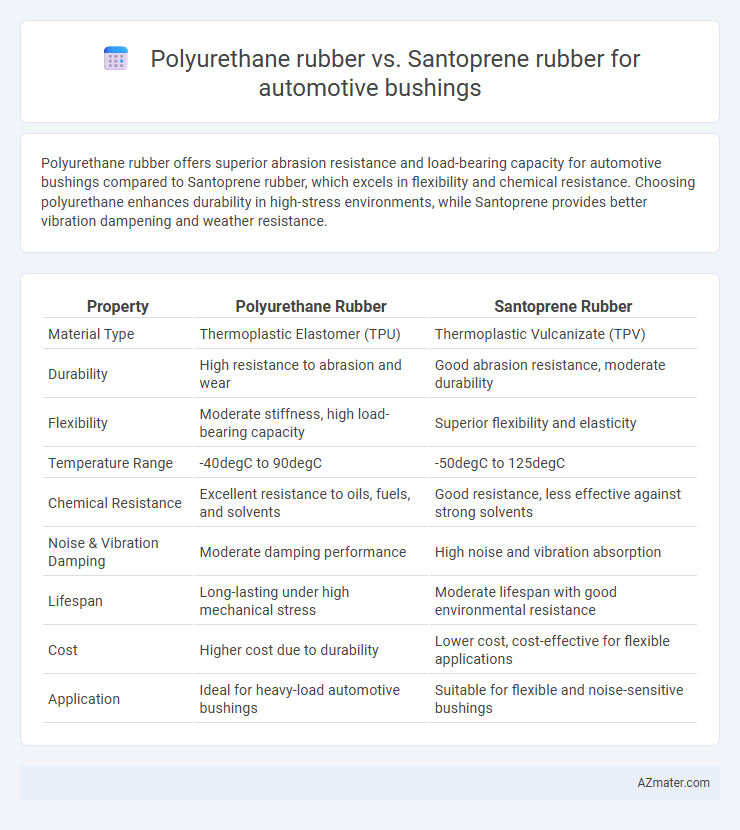Polyurethane rubber offers superior abrasion resistance and load-bearing capacity for automotive bushings compared to Santoprene rubber, which excels in flexibility and chemical resistance. Choosing polyurethane enhances durability in high-stress environments, while Santoprene provides better vibration dampening and weather resistance.
Table of Comparison
| Property | Polyurethane Rubber | Santoprene Rubber |
|---|---|---|
| Material Type | Thermoplastic Elastomer (TPU) | Thermoplastic Vulcanizate (TPV) |
| Durability | High resistance to abrasion and wear | Good abrasion resistance, moderate durability |
| Flexibility | Moderate stiffness, high load-bearing capacity | Superior flexibility and elasticity |
| Temperature Range | -40degC to 90degC | -50degC to 125degC |
| Chemical Resistance | Excellent resistance to oils, fuels, and solvents | Good resistance, less effective against strong solvents |
| Noise & Vibration Damping | Moderate damping performance | High noise and vibration absorption |
| Lifespan | Long-lasting under high mechanical stress | Moderate lifespan with good environmental resistance |
| Cost | Higher cost due to durability | Lower cost, cost-effective for flexible applications |
| Application | Ideal for heavy-load automotive bushings | Suitable for flexible and noise-sensitive bushings |
Introduction to Automotive Bushings
Automotive bushings, essential components in vehicle suspension systems, provide vibration isolation and reduce noise by absorbing shocks and movements between metal parts. Polyurethane rubber offers high durability, resistance to oil, and superior load-bearing capacity, making it ideal for performance-driven applications. In contrast, Santoprene rubber combines the flexibility of elastomers with excellent weather, chemical, and abrasion resistance, providing a balance of comfort and longevity for standard automotive bushings.
Overview of Polyurethane Rubber
Polyurethane rubber is widely favored for automotive bushings due to its exceptional abrasion resistance, high tensile strength, and remarkable durability under dynamic loads. Its ability to maintain flexibility and resist oil, grease, and temperature extremes makes it ideal for suspension components experiencing continuous stress and environmental exposure. Compared to Santoprene rubber, polyurethane delivers superior performance in minimizing deflection and improving vehicle handling stability.
Overview of Santoprene Rubber
Santoprene rubber, a thermoplastic elastomer, combines the flexibility of rubber with the processing ease of plastics, making it ideal for automotive bushing applications requiring durability and vibration dampening. It offers superior resistance to chemicals, heat, and weathering compared to polyurethane rubber, enhancing long-term performance in harsh engine environments. Santoprene's excellent compression set and flexibility improve ride comfort and noise reduction, making it a preferred choice for automotive suspension components.
Material Properties Comparison
Polyurethane rubber offers superior abrasion resistance, higher tensile strength, and excellent load-bearing capacity compared to Santoprene rubber, making it ideal for high-performance automotive bushings subjected to intense mechanical stress. Santoprene rubber provides better flexibility, excellent vibration dampening, and enhanced weather resistance, which contributes to noise reduction and longer service life in varying environmental conditions. Both materials exhibit good chemical resistance, but polyurethane's rigidity supports greater durability in heavy-duty applications while Santoprene's elastomeric nature ensures improved comfort and resilience.
Durability and Wear Resistance
Polyurethane rubber offers superior durability and wear resistance compared to Santoprene rubber, making it ideal for automotive bushings subjected to extreme mechanical stress. Its high tensile strength and excellent abrasion resistance ensure longer service life in harsh environments, including exposure to oils and chemicals. Santoprene rubber provides good flexibility and moderate wear resistance but tends to degrade faster under heavy loads and continuous friction.
Performance in Extreme Temperatures
Polyurethane rubber offers excellent durability and flexibility in extreme temperatures ranging from -40degC to 80degC, maintaining its mechanical properties under intense thermal stress, which is critical for automotive bushings exposed to harsh environments. Santoprene rubber exhibits superior low-temperature flexibility down to -50degC and retains elasticity up to 135degC, making it ideal for applications requiring consistent performance across a broader temperature range. While polyurethane is more resistant to abrasion and wear, Santoprene provides better thermal stability and vibration damping in automotive suspension components.
Noise, Vibration, and Harshness (NVH) Control
Polyurethane rubber offers superior durability and stiffness compared to Santoprene rubber, resulting in enhanced control of harshness and improved handling in automotive bushings. Santoprene rubber excels in noise and vibration absorption due to its elastomeric properties, providing a smoother, quieter ride. Selecting polyurethane or Santoprene balances NVH performance with longevity, depending on whether stiffness or cushioning is prioritized.
Chemical and Oil Resistance
Polyurethane rubber offers superior chemical and oil resistance compared to Santoprene rubber, making it ideal for automotive bushings exposed to harsh fluids and solvents. Its molecular structure provides enhanced durability against hydrocarbons, greases, and engine oils, ensuring longer service life under aggressive conditions. Santoprene, while flexible and resistant to weathering, exhibits lower resistance to prolonged chemical exposure and may degrade faster in heavy oil environments.
Cost and Availability
Polyurethane rubber offers superior durability and performance for automotive bushings but tends to be higher in cost and sometimes less readily available compared to Santoprene rubber. Santoprene rubber provides a cost-effective solution with widespread availability and good flexibility, making it suitable for mass production in automotive applications. Manufacturers often choose Santoprene for budget-sensitive projects, while polyurethane is preferred when long-term wear resistance justifies the investment.
Application Suitability and Recommendations
Polyurethane rubber offers superior durability and resistance to abrasion, making it ideal for high-load automotive bushings exposed to harsh environments and frequent mechanical stress. Santoprene rubber provides excellent flexibility and vibration damping, which is better suited for applications requiring noise reduction and improved ride comfort in suspension bushings. For heavy-duty and performance-focused automotive bushings, polyurethane is recommended, while Santoprene is preferred for parts prioritizing flexibility and noise isolation.

Infographic: Polyurethane rubber vs Santoprene rubber for Automotive bushing
 azmater.com
azmater.com